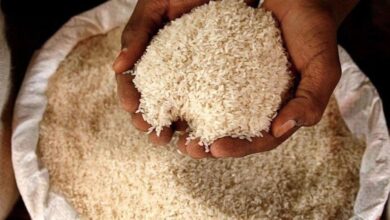
India’s wheat output set to touch a new record at 112.74 million tonnes in 2022-23: Govt data
According to the latest data released by the agriculture ministry, India’s wheat production is expected to reach a new record of 112.74 million tonnes in the 2022-23 crop year. This is an increase of five million tonnes from the previous year. Despite unseasonal rains, the higher production is attributed to increased acreage and yield.
In addition to wheat, record outputs have been estimated for rice, maize, oilseeds, and sugarcane. The overall foodgrains output for the country in the 2022-23 crop year is projected to be a record 330.53 million tonnes. This is a significant increase from the actual output of 315.61 million tonnes in the previous crop year, as per the third estimate provided by the agriculture ministry.

This boost in agricultural production is encouraging for India, as it signifies improved productivity and the potential to meet domestic demand while potentially having a surplus for exports. Higher agrarian output can also contribute to food security, income generation for farmers, and overall economic growth in the country.
India is set to achieve a new record in its foodgrain production, with wheat playing a significant role.
The agriculture ministry has released data indicating that the country’s wheat production for the ongoing 2022-23 crop year is estimated to reach 112.74 million tonnes, surpassing the previous year’s output by 5 million. This increase is attributed to factors such as expanded acreage and improved yield, despite facing unseasonal rains.
During the 2021-22 crop year, wheat production had declined to 107.74 million tonnes due to a heat wave in key growing states. However, the current estimate of 112.74 million tonnes surpasses the previous record of 109.59 million tonnes achieved during the 2020-21 crop year. The sowing of wheat, which is the primary rabi (winter) crop, began in October, and harvesting is expected to be completed by June 15 of this year.
In addition to wheat, other crops in India have also witnessed record outputs. According to the third estimate provided by the agriculture ministry, rice production is projected to reach a record 135.54 million tonnes in the 2022-23 crop year, compared to 129.47 million tonnes in the previous year. Maize production is also expected to set a new record at 35.91 million tonnes, surpassing the 33.73 million tonnes produced in the same period.
The foodgrain basket in India comprises wheat, rice, Nutri-coarse cereals, and pulses. Achieving record production levels in these crops is a significant accomplishment for the country. It has implications for food security, domestic consumption, and the potential for export surplus. The increased agricultural output also contributes to the income generation of farmers and overall economic growth.
The rise in wheat production can be seen as a positive outcome after the previous year’s decline caused by unfavourable weather conditions. The expansion of acreage and improved yield signify the resilience of Indian agriculture and the efforts made by farmers to overcome challenges. It also highlights the effectiveness of government initiatives and policies aimed at boosting agricultural productivity.
With record-setting rice production, India further solidifies its position as one of the world’s leading rice producers. Rice is a staple crop in the country and a crucial component of its food culture. The increased output is expected to meet domestic demand, support government welfare programs, and potentially open avenues for export opportunities.

The significant growth in maize production is also noteworthy. Maize is used in various sectors, including animal feed, food processing, and the production of biofuels. A record harvest can benefit industries reliant on maize and contribute to the overall economy.
The estimated record foodgrains output of 330.53 million tonnes for the 2022-23 crop year, compared to the actual production of 315.61 million tonnes in the previous year, signifies a positive trend in India’s agricultural sector. It demonstrates the resilience and adaptability of Indian farmers and their ability to leverage technological advancements, improved farming practices, and government support to enhance productivity.
The increased foodgrain production not only ensures food security but also has the potential to stabilize prices and reduce dependency on imports. It provides opportunities for income generation, reduces rural-urban migration, and supports sustainable development in rural areas.
In addition to the significant increases in wheat, rice, and maize production, India has also witnessed growth in the production of nutri-coarse cereals and pulses, although there are some variations among different crops. The total output of nutri-coarse cereals, including maize, has reached 54.74 million tonnes in the 2022-23 crop year, compared to 51.10 million tonnes in the previous year.
Regarding pulses, the estimated production for 2022-23 is slightly higher at 27.50 million tonnes, compared to 27.30 million tonnes in the previous year. However, there are variations in the production levels of specific pulse crops. While gram production is estimated to remain relatively flat at 13.54 million tonnes in the same period, tur and urad production is expected to decline.
Our production is projected to be lower at 3.43 million tonnes, compared to 4.22 million tonnes in the previous year. Similarly, urad output is anticipated to decrease to 2.61 million tonnes from 2.77 million tonnes. These reductions in tur and urad production could be attributed to various factors such as weather conditions, pest infestation, or changes in cultivation practices.
It’s worth noting that despite the slight decline in tur and urad production, the overall pulse production in India is still higher compared to the previous year. This indicates a positive trend in pulse cultivation and efforts to meet the increasing demand for these protein-rich crops.
The production of nutri-coarse cereals and pulses is vital for enhancing food and nutritional security in India. These crops are a significant source of dietary diversity and are crucial in providing essential nutrients to the population. They also contribute to the income of farmers engaged in their cultivation.

Although there are variations in production levels among different crops within the nutri-coarse cereals and pulses categories, the overall increase in production signifies progress in India’s agricultural sector. It highlights the efforts made by farmers and the impact of government interventions aimed at promoting sustainable agricultural practices and improving productivity.
As India continues to focus on enhancing its agricultural output, addressing challenges in specific crops, such as tur and urad, could be a priority. Implementing measures to mitigate the factors causing the decline in production, such as pest management strategies, promoting resilient varieties, or providing technical support to farmers, can help stabilize and increase the production of these crops.
Overall, the growth in nutri-coarse cereal and pulse production, along with the record outputs in wheat, rice, and maize, contributes to India’s increasing foodgrain production. This achievement is significant for ensuring food security, meeting domestic demand, supporting welfare programs, and potentially exporting surplus produce.
It also highlights the resilience and adaptability of Indian farmers in addressing challenges and maximizing agricultural productivity.In addition to food crops, India has also experienced significant growth in the production of cash crops. The production of sugarcane, a major cash crop, is estimated to reach a record 494.22 million tonnes in the 2022-23 crop year, compared to 439.42 million tonnes in the previous year. This increase in sugarcane production is likely driven by factors such as favourable weather conditions and increased cultivation.
Cotton production, another critical cash crop, is projected to be higher at 34.34 million bales of 170 kg each in the current crop year. This is an improvement from the 31.11 million bales produced in the 2021-22 crop year. The increase in cotton production can be attributed to expanded cultivation areas, improved farming practices, and favourable market conditions.
However, in the case of jute/mesta production, there has been a decline. The estimated production for 2022-23 is 9.49 million bales of 180 kg each, compared to 10.14 million bales in the previous year. The decrease in jute/mesta production could be due to various factors, including fluctuations in demand, disease outbreaks, or changes in cultivation patterns.
It’s important to note that the government releases multiple estimates at different stages of crop growth and harvesting before the final estimate. These estimates provide valuable insights into the crop’s progress and allow for timely adjustments in policies and interventions, if necessary.
The growth in cash crop production, such as sugarcane and cotton, is significant for India’s agricultural economy. Sugarcane is a vital crop for the country’s sugar industry and plays a crucial role in rural employment and income generation. Increased sugarcane production can help meet the growing demand for sugar, support the sugar industry’s sustainability, and contribute to the overall economy.
Cotton, on the other hand, is a major cash crop that contributes to the textile and garment industries. Higher cotton production ensures a stable supply of raw materials for these industries, supports value addition and export earnings and provides employment opportunities in rural and urban areas.
While jute/mesta production has experienced a slight decline, efforts to stabilize and improve production levels can help maintain the availability of this versatile fibre for various industries, such as textiles, packaging, and eco-friendly products.
The government’s provision of multiple estimates throughout the crop growth and harvesting stages enables better planning, monitoring, and decision-making for both farmers and policymakers. It allows for timely interventions and support, such as improved irrigation facilities, pest control measures, market linkages, and price stabilization measures, to maximize crop yields and address any challenges that may arise.
Overall, the record production of sugarcane and increased cotton production, along with the fluctuations in jute/mesta production, reflect the dynamic nature of India’s cash crop sector. It highlights the importance of continuous monitoring, adaptive policies, and targeted interventions to support the growth and sustainability of these crops, benefiting farmers, industries, and the national economy.






